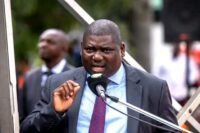THE Energy Regulation Board (ERB) says there will be no adjustment on fuel pump prices.
In a Press statement issued in Lusaka today, the board said this is in line with the “cost-plus model” which is currently used to set fuel prices.
ERB also said that the decision was in line with the policy guidance at the last price adjustment that fuel prices shall be reviewed after every 60 days.
“This is because the marginal price increase for the current consignment that would have been made is lower than 2.5%-to the minimum threshold for adjusting prices under the cost plus model. Therefore while the cost of petroleum feedstock and finished petroleum products currently on the market is slightly higher than that of the last assessed cargo, no adjustment shall be made,” read the statement in part.
“The Government of the Republic of Zambia imports a commingled petroleum feedstock typically consisting of; petroleum feedstock (41%); condensate/ naphtha (13%); and gasoil (diesel) (46%). In turn the ERB determines the wholesale and pump prices. The consignment whose wholesale pricing was being determined are (i) 105,018 metric tonnes of petroleum feedstock cargo carried by MT. DeshMahima. The feedstock cargo berthed and discharged at the port of Dar-es-Salaam from 26th to 28th December, 2016 and (ii) Fished petroleum products (petrol amounting to 37, 904.45 cm and diesel amounting to 79, 692.93m), that was imported beginning from 11th February to 31st March 2017.”
The statement has further stated that fuel prices in Zambia are largely determined on the basis of two factors which are international oil prices and the exchange rate of the Zambian Kwacha against the United States Dollar.
“Between August 2016 and January 2017, international oil prices generally increased. Specifically, International oil prices gradually rose from US$44.72/barrel (bbl) in August to US$51.35/ bbl in October. Further, from November 2016 to January 2017, a much steeper rise is international oil prices was observed. However, there was a fall in oil prices in November 2016 mainly attributed to rising crude inventories in the United States of America and elsewhere in the world, mainly owing to record output by the organization of petroleum exporting countries,” the statement further read.
“With regard to the exchange rate, between August 2016 and February 2017, the kwacha traded between $9.76 and $10.0. During that period, the kwacha appreciated against the United States Dollar while from November to January 2017, it depreciated. However, by February 2017, the local currency had again appreciated to $9.76.”
The statement has indicated that in view of the forgoing, a combined effect of the import cost, for petroleum feedstock and finished petroleum products, wholesale and pump prices are retained at current levels shows that there would be marginal losses.
“This therefore implies that wholesale and pump prices would need to be adjusted slightly upwards to allow for recovery of cost. However to allow for price stability and in keeping with the application of the cost plus model, a price adjustment can only be implemented if wholesale prices rose or reduced by 2.5%. Therefore, under the circumstances, the wholesale and pump prices shall remain unchanged. Based on the announcement by the board in January 2017, the pump prices for petroleum products shall remain as follows at K12.50 for petrol, K10.72 for Diesel, K 6.81 Kerosene, and K13.01 Low Sulphur gas (diesel),” read the statement.












